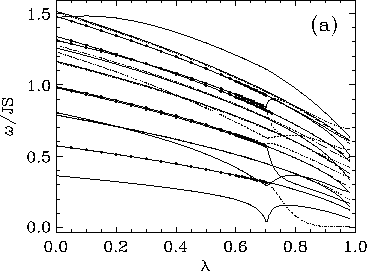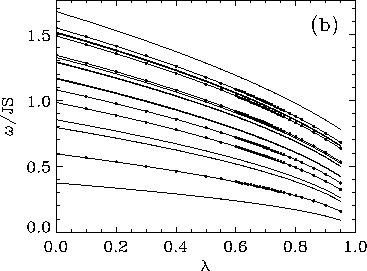 for these modes of the
in-plane vortex. And, once again, there are modes higher up in the spectrum
with downward cusps at
for these modes of the
in-plane vortex. And, once again, there are modes higher up in the spectrum
with downward cusps at  .
.
We can also consider how the size of the system affects the low-frequency
spectrum. For example, the lower part of the spectrum for a system with 492
sites is shown in Fig. 4a. In general the low-frequency modes found
for the 180-site system are also seen in the 492-site system, but slightly
shifted in frequency. The same sets of two-fold degeneracies are also found,
which are again related to a symmetry in  for these modes of the
in-plane vortex. And, once again, there are modes higher up in the spectrum
with downward cusps at
for these modes of the
in-plane vortex. And, once again, there are modes higher up in the spectrum
with downward cusps at  .
.


Figure 4:
Comparison of the lowest 19 modes in the spinwave spectrum for a
square lattice circular system with 492 sites, with fixed boundary conditions, (a)
containing an in-plane vortex at its center, and (b) no vortex (spinwave
modes about ferromagnetically aligned state).
The solid and dotted lines are used only to distinguish nearby modes.
In Fig. 4b, the low-frequency spectrum for the 492-site system
without a vortex is shown. The sites were initially aligned in the xy-plane
ferromagnetically. We find more or less the same sequence of nondegenerate and
degenerate modes, which do not split at any  . There is no mode that
goes soft, as expected, since the ferromagnetic state is a stable energy
minimum for
. There is no mode that
goes soft, as expected, since the ferromagnetic state is a stable energy
minimum for  , and there are no cusps.
, and there are no cusps.